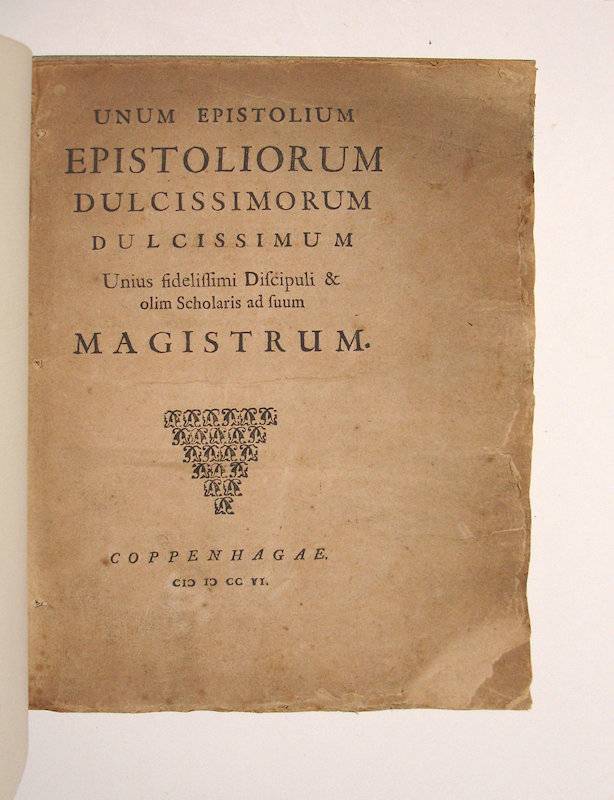BURMANNUS, PETRUS.
Unum epistolium epistoliorum dulcissimorum dulcissimum, unius fidelissimi discipuli & olim scholaris ad suum magistrum.
Copenhagen (Coppenhagae), 1706.
4to. (II),70 p. Modern boards. 22 cm 'Written cum maxima fractura capitis & labore' (
Ref: STCN ppn 183625013; Knuttel 15549) (
Condition: Paper browning. Edges of the title and second leaf chipped) (
Note: The Roman author, orator and politician Cicero enjoyed his greatest glory during the Renaissance, 'when he became not only a historical figure and a writer but also the object of the literary cult known as Ciceronianism'. (The Classical Tradition, Cambr. Mass., 2010, p. 195) Petrach established Cicero as a uniquely powerful stylistic source and intellectual resource. 'In the later 15th century Humanists like Angelo Poliziano and Filippo Beroaldo began to widen the range of Latinity: they commented on and sometimes imitated Quintilian, Statius, Apuleius, and others.' (Op. cit., p. 196) Thanks to humanistically inclined popes Ciceronianism, the endeavour to imitate, or even ape the pure Latinity of Cicero, won the debate. In 1528 Desiderius Erasmus published his 'Ciceronianus', a treatise that attacked the Ciceronian pedantic Latin written by many scholars during the early 16th century. But, 'over time a moderate Ciceronianism , generally classical, but not extremist, became the norm, in Protestant 'Gymnasien' in North Germany (and the Netherlands), Jesuit schools from Paris to Prague, and English grammar schools alike. Despite the late 16th century vogue for Tacitus, Cicero retained his central position as a school author and a model for good writing of many kinds'. (Op. cit., p. 197) In the late 17th and the 18th centuries Cicero's works continued to be committed to memory in schools, as an example of good taste. Now, having acquired the principal rules, and a competent knowledge of the language, the student was adviced for his grammatical studies to peruse constantly and carefully the works of Cicero, and authors like Terentius and Caesar, in order to absorb the structure and idiom of pure Latinity.
§ The Dutch scholar Pieter Burman, or Petrus Burmannus, 1668-1741, appointed in 1696 professor of History and of Latin at Utrecht, was one of the advocates of an elegant Latin style. In 1706 Burmannus published this satyrical letter, supposedly written by one Stephanus Spinaeus, to denounce the horrible dog-Latin of some of his colleagues, for instance the Dutch scholar Melchior Leidecker, 1642-1721, who was professor of Theology since 1678 at the university of Utrecht. Leydecker wrote a kind of barbaric Latin which no one could understand, unless he spoke Dutch. (Chr. Sepp, 'Het godgeleerd onderwijs in Nederland gedurende de 16e en 17e eeuw', Leiden 1873, p. 353) In this letter Burmannus sins against every rule of good taste and style, it teems with mistakes, barbarisms, solecisms, and idiomatic constructions in vernacular, but translated into Latin. Poking fun at Leydecker, Burmannus writes, that he wrote the letter 'cum maxima fractura capitis & labore'. This satyrical letter was published anonymously, and supposedly in Copenhagen. This is of course a mystification. It was printed in the Netherlands, probably Utrecht) (
Collation: pi1, A-I4 (minus leaf I4. Leaf I4 was probably used for pi1, the title)) (Photographs on request)
Book number: 130028 Euro 190.00
Keywords: (Oude Druk), (Rare Books), Brief, Ciceronianismus, Letter, Neolatin, Neulatein, University of Utrecht, antike altertum antiquity, ciceronianism, epistula, satire, satyra
 BURMANNUS, PETRUS.
BURMANNUS, PETRUS.